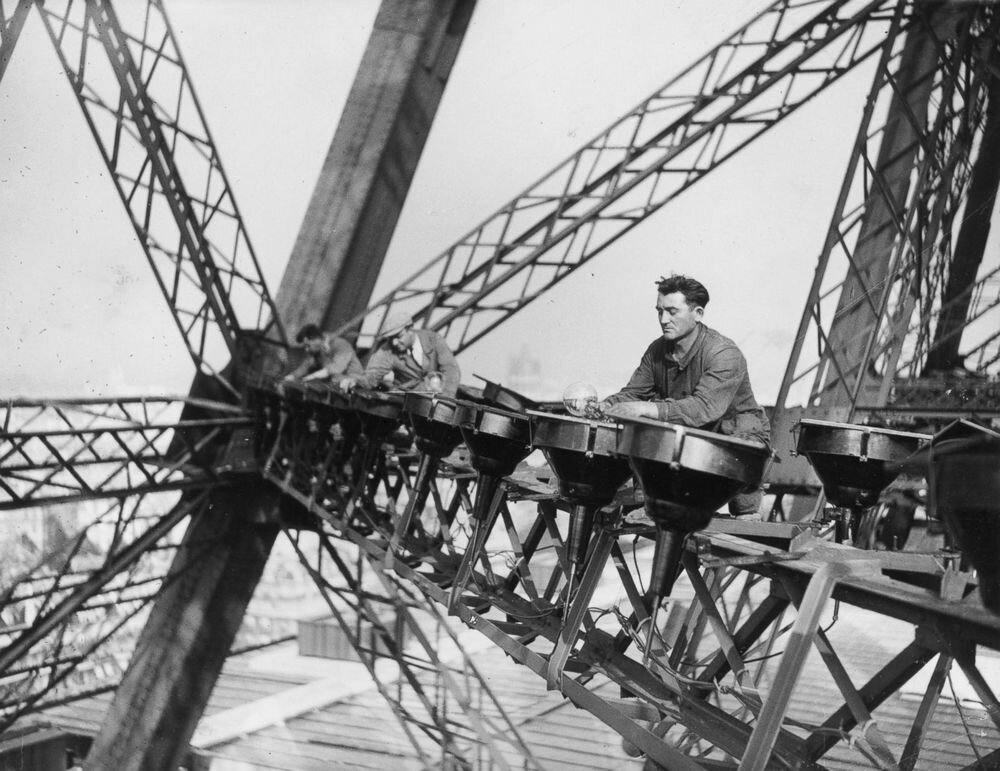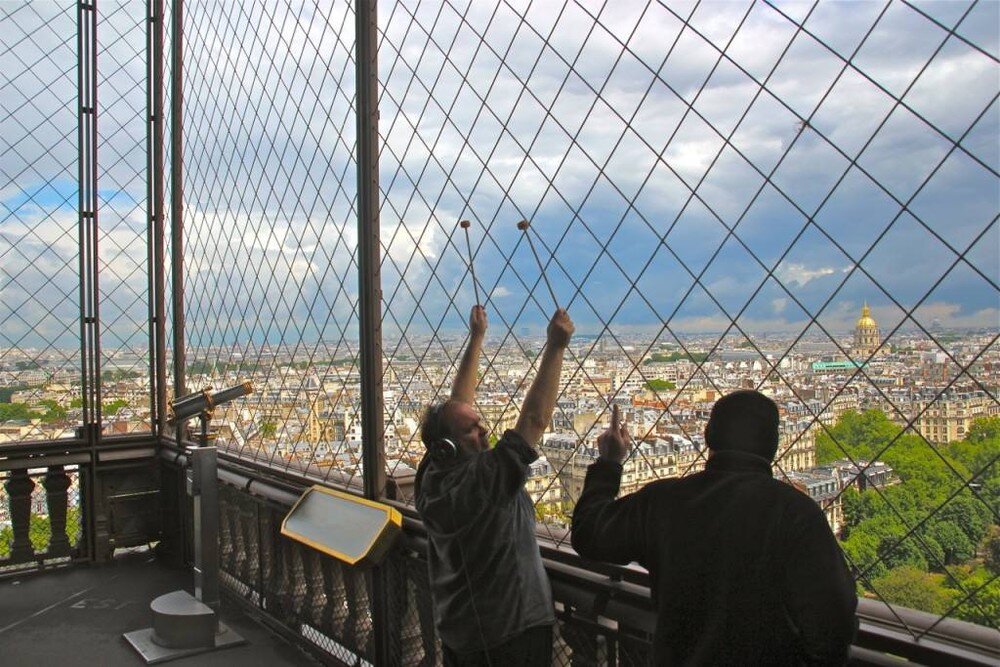Joseph Bertolozzi: Tower Music
Each leg of the Eiffel Tower rests on four 2-meter concrete slabs, each of which support blocks of limestone on which the foundations for the ironwork of the structure rest. Each foundation — or “shoe,” in architectural terms — is anchored to the limestone by pairs of 25-foot long, 4-inch wide bolts. The work required for the structure was excruciating, both in terms of labor and architectural planning; it is believed that the drawing office produced over 3,600 detailed drawings of the plans and that their execution required over 18,000 different parts, conjoined by about 2.5 million rivets. The structure contains three lifts for visitors who choose not to climb the stairs to reach the top. The dimensions of the wrought iron lattice tower are 324-meters tall by 125-meters wide on each side, making it the tallest structure in Paris. Construction began on January 28, 1887 and ended on March 15, 1889, just in time for its March 31st unveiling as the entrance to the 1889 Exposition Universelle (World’s Fair). The tower took the labor of around 300 workers, not including those who manufactured and transported the iron and stone. One person died during its construction.
Workers installing lights on the tower.
The tower was the vision of Gustave Eiffel, the French engineer and architect. When he presented his initial plans in 1885, he indicated that the tower’s possibility was “prepared by the great scientific movement of the eighteenth century and by the Revolution of 1789, to which this monument will be built as an expression of France’s gratitude.” He likened the tower to the pyramids and pointed out the fact that it would be the tallest structure ever built on the planet. Artists in the 19th century, however — namely Guy de Maupassant, Charles Gounoud, and Jules Massenet — actually petitioned against the tower being built, envisioning the final product as
a giddy, ridiculous tower dominating Paris like a gigantic black smokestack, crushing under its barbaric bulk Notre Dame, the Tour Saint-Jacques, the Louvre, the Dome of les Invalides, the Arc de Triomphe, all of our humiliated monuments will disappear in this ghastly dream. And for twenty years… we shall see stretching like a blot of ink the hateful shadow of the hateful column of bolted sheet metal.
With Tower Music (2016) composer and organist Joseph Bertolozzi seeks to give voice to the magnificent tower, turning it into a musical instrument, allowing it to speak through his percussion instruments and production techniques. These instruments include all sorts of mallets, from wooden to latex, as well as invented instruments, such as a tree stump hanging from cables and necklaces on a turning wheel. Using these instruments, Bertolozzi played rhythms on numerous points on the structure, evoking the many tensions and timbres that are hidden within it. The composer does not seem to be banging completely at random, however; one scene from the record’s promotional video shows him marking a B-flat on an iron beam, which exposes an interesting aspect of his approach. The end of the video shows Bertolozzi matching the pitches of an ambulance or police car on a pitch pipe, evidencing the aesthetic goal of this project: to discern and organize the sensual dimensions of the institutions of capital.
This is where the record becomes problematic, however, because while on the surface it seems as if he is attempting to continue or critique the serious percussion works of John Cage or Steve Reich — whose own works are formally problematic in various ways — the idea of this project in itself is actually rather opaque. Cage attempted to use both existing and invented “instruments,” from radios to prepared pianos, on their own terms, to investigate their own qualities in space and time. Tower Music wants to walk that path; however, in post-production, it selects the road toward Aphex Twin instead, opting for more processed and less (seemingly) autonomous organizational methods. In this sense Bertolozzi does seem to be attempting to find a solution for the informality of the works of Cage and others; however, the problem is the formal structures into which he presses these fantastic sounds.
The sounds of the tower, both percussed and ambient, are the most interesting dimensions of this project; yet, they are also what become the most compromised through Bertolozzi’s treatment of them. In another video Bertolozzi discusses the microtonal aspects of the iron beams and rails, addressing the fact that although a specific rail may sound most like an A or an F, that each tone carries a plethora of overtones within it, and that in hitting multiple notes simultaneously, each evokes different properties from the other. Here Bertolozzi has stumbled onto something nuanced about the particularity of the Eiffel Tower. To actually study the tower's musical properties immanently, however, Tower Music would have needed to further interrogate these qualities and to more thoroughly disclose the specificity of the actual conditions of the tower through composition. In theory, perhaps an album of field recordings from the Eiffel Tower would better achieve his goal of evoking the soul of the tower; this hypothetical record would simply exhibit the sounds he has extracted, which are themselves unique achievements. This would be problematic, though, in that they would be essentially formless, and would fall more into the category of ethnomusicological field recording than composition.
“The Harp That Pierced the Sky” is a compelling moment on the album, because it allows the tones to breathe and move more autonomously through time, giving the listener a chance to actually hear the sounds of the tower. Similarly, the ambiance of “Evening Harmonies” gives impressions of the tower after hours, as it continues to settle into the Earth, creaking and moaning, animals scurrying about its beams and walkways. However, other tracks, such as “Glass Floor Rhythms” and “A Thousand Feet of Sound,” are more aggressively focused on rhythm and post-production than the sounds of the tower itself. Although it is obvious that "Ironworks" is meant to sound like aestheticized labor, a musical version of what one may have heard wafting from the tower's construction site in 1889, its theatricality and drive make it seem like a glitchy film score for a neo-noir or techno-thriller.
The postmodern composer that comes to mind when thinking about Bertolozzi is music’s other protagonist of musical architecture, Iannis Xenakis. Using equations and architectural ratios, Xenakis composed music using the mathematical process of planning and creating structures, turning the internal rationality of capital against itself. It was either to fulfill the needs or to react against the needs of late capital that the various schools of post-war architectural science were developed, and Xenakis, a student of the latter, applied these theories to his music. It was through his relationship to these structures and the process of their creation that he was able to contribute to — and critique — the post-World War II outbreak of formal responses to atonality.
Instead of evoking and investigating the reason or history of the Eiffel Tower, Bertalozzi simply turns it into another musical instrument. Through his unveiling of the sounds and tensions of the structure, he is also validating the labor that created it, which, too, is concealed within. With each shimmering tone and bellowing pitch that Bertalozzi pulls from the structure, the listener is simultaneously hearing the cries of the revolutionaries of 1789 and the grunts and sighs of the laborers that built the tower. Yet all we really hear are the beats. History is lost through the fetishization of the structure, which actually has no import whatsoever in this record, becoming simply another tool of production; if one listened to these compositions without knowing their background, the instrument of their creation may as well be the St. Louis Arch, Brandenburger Tor, or the Statue of Liberty. //
Frank Palaia, Joseph Bertolozzi and Joe Popp recording the Eiffel Tower, 2016.


